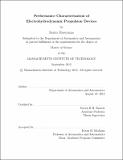Performance characterization of electrohydrodynamic propulsion devices
Author(s)
Masuyama, Kento
DownloadFull printable version (3.433Mb)
Other Contributors
Massachusetts Institute of Technology. Dept. of Aeronautics and Astronautics.
Advisor
Steven R.H. Barrett.
Terms of use
Metadata
Show full item recordAbstract
Partially ionized fluids can gain net momentum under an electric field, as charged particles undergo momentum-transfer collisions with neutral molecules in a phenomenon termed an ionic wind. Electrohydrodynamic thrusters generate thrust by using two or more electrodes to ionize the ambient fluid and create an electric field. In this thesis, electrohydrodynamic thrusters of single- and dual-stage configurations were tested. Single-stage thrusters refer to a geometry employing one emitter electrode, an air gap of length d, and a collector electrode with large radius of curvature relative to the emitter. Dual-stage thrusters add a collinear intermediate electrode in between the emitter and collector. Single-stage thruster performance was shown to exhibit trends in agreement with the one-dimensional theory under both positive and negative DC excitations. Increasing the gap length requires a higher voltage for thrust onset, generates less thrust per input voltage, generates more thrust per input current, and most importantly generates more thrust per input power. A thrust-to-power ratio as high as 68.43 mN/W was obtained for a d = 21 cm thruster. Dual-stage thrusters were shown to be more effective than its single-stage counterpart of equal total gap length at producing current, leading to a smaller total voltage necessary for producing equal thrust. However, losses involving ion collection at the intermediate electrode led to reduced thrust-per-power compared to the single-stage of equal length. A factor was defined in order to characterize these losses, and the theoretical dependence of thrust-to-power on was experimentally confirmed. A nondimensional quality term was derived, allowing for comparisons between the measured thrust-to-power values and the theoretical predictions.
Description
Thesis (S.M.)--Massachusetts Institute of Technology, Dept. of Aeronautics and Astronautics, 2012. Cataloged from department-submitted PDF version of thesis. This electronic version was submitted and approved by the author's academic department as part of an electronic thesis pilot project. The certified thesis is available in the Institute Archives and Special Collections. Includes bibliographical references (p. 103-105).
Date issued
2012Department
Massachusetts Institute of Technology. Department of Aeronautics and AstronauticsPublisher
Massachusetts Institute of Technology
Keywords
Aeronautics and Astronautics.